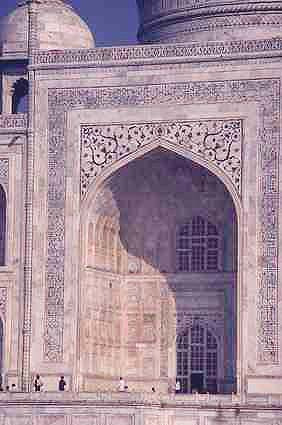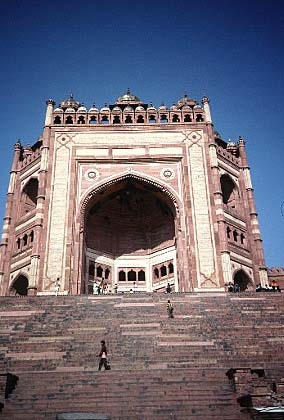Don't wanna be here? Send us removal request.
Text
A Day in Jama Masjid, Delhi

The Jama Masjid of Delhi is known to be one of the largest mosques in India. This large mosque was commissioned by Emperor Shah Jahan between 1650 and 1656 and designed by Ustad Ahmad Lahori who died in 1649 before the building’s construction began. This building consists of a mixture of marble and limestone, and it has three colossal domes, four towers, and one hundred thirty-one minarets making it one of the largest mosques (Revv). This fascinating Mughal monument can accommodate as many as 25,000 people during the holy prayers and is known to be one of the major symbols of Islamic power across all of India.
0 notes
Text
A Day at Red Fort, Delhi

Mughal emperor Shah Jahan decided to shift the capital from Agra to Delhi and commissioned the construction of the Red Fort in Delhi also known as Lal Qila on 12 May 1638, which was completed within the next ten years by Ustad Ahmad Lahori who also happened to build the Taj Mahal alongside Jahan. Located in Old Delhi, this building was known as a primary residence of the Mughal emperors for approximately 200 years. It is mainly made of red sandstone and is known to be one of the designated UNESCO World Heritage Sites.
0 notes
Text
A Day at The Taj Mahal


When Akbar’s reign came to an end, new emperors led the Mughal Empire after his death. His grandson Shah Jahan was among one of the emperors to eventually take reign of the empire. Jahan’s reign is significantly remembered for its architectural influence. One of the architectures he’s best known for is the Taj Mahal, built as a tomb for Jahan’s favorite wife Mumtaz Mahal in 1631 and 1632 on the southern bank of the Yamuna River and is located in the Mughal capital of Agra. This building showed great similarities to Humayum’s tomb built in 1570 due to them both being Mughal garden tombs that were built by widows who honored their loved ones. Although, over time architecture has improved greatly and that is shown by the comparison of these two buildings. The Taj Mahal demonstrates to be levels ahead in terms of size, scale, and craftsmanship. Because of Jahan’s architectural ambition, the process took over twenty years to complete and required many architects from Central India and Western Asia in order to achieve the masterpiece.
0 notes
Text
A Day in Fatehpur Sikri, Buland Darwaza


Despite not designing and building Humayum’s tomb in Delhi, Akbar completed his new city named Fatehpur Sikri in 1578. The city was made up of a mosque, a palace, a lavish and huge garden, a worship hall for Din-i Ilahi, and a tomb for Shaykh Salim Chishti who was Akbar’s closest and most beloved religious advisor (Hooker). Fatehpur Sikri was a city that represented the rule of his empire and his gratitude to religion. In 1573, the Mughal emperor built Buland Darwaza also known as the “Door of victory” to commemorate his victory over Gujarat in 1573. It is made up of sandstone, just like the whole city, with white and black marble decorations that are enhanced with stone carvings and inscribed quotes from Quran. The Quran was very important to the Mughals and was especially important to Akbar. It stated that all mankind was made up of one soul and one single nation. The Holy Quran also advised them to acknowledge the advancing discoveries of science and philosophy in order to survive (The Star of Islam). This gate is the tall entrance into the courtyard around the great mosque at Fatehpur Sikri, the Jami Masjid. During Akbar’s reign, the city he saw as perfect served as his capital for a while but soon began to vanish soon after his death due its location far from water.
0 notes
Text
A Day in Humayan's Tomb in Delhi

The Mughal Empire of India was established in 1526 but it wasn’t until 1556 when the expansion began under the reign of Akbar shortly after his father’s death. The empire was wealthy in architecture and population during his reign but especially wealthy in culture as many were allowed to keep their languages and religions. Being mainly made up of red sandstone and white marble, Humayum’s tomb was commissioned by Humayum’s first wife and designed by Mirah Mirza Ghiyath from 1562 to 1571 to honor his reign before his death on January 24, 1556. This was the first major garden-tomb building to be built under Akbar’s rule of the Mughal Empire on the Indian subcontinent. The tomb is well known for Persian influenced architecture and for being home to over one hundred gravestones for the Mughal population. Located on a high plinth 6.5m tall and 99m wide, the tomb is also square-shaped with chamfered corners and is separated into four recesses with a slightly curved dome (Lowry). Its size and symmetrical aspects are truly remarkable and have influenced several structures in India with similar features to Humayum’s tomb.
2 notes
·
View notes